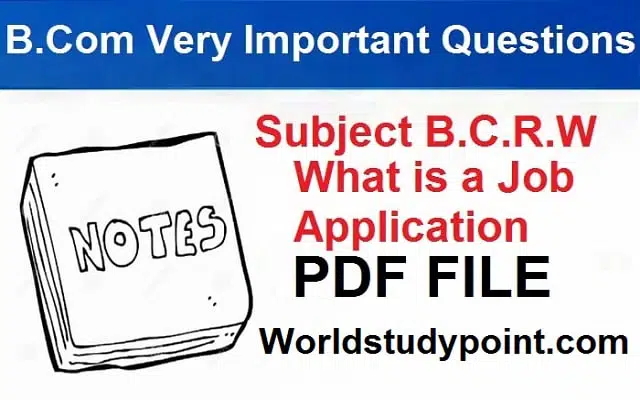Table of Contents
What is a Job Application? What Are Its Types? Discuss the Essentials of a Job Application.
Definition:
A job application is essentially a formal letter in which an individual presents their skills, qualifications, experience, and services to a potential employer. It serves as a sales pitch, where the applicant “sells” themselves to the organization in hopes of securing employment.
Types of Job Applications:
Job applications generally fall into two main categories:
-
Solicited Applications
-
Unsolicited Applications
1. Solicited Applications:
A solicited application is written in response to a job advertisement published by an employer. These applications are tailored to meet the specific requirements mentioned in the job posting, such as educational background, experience, and age limit.
Advantages:
-
The applicant is aware that a job vacancy exists.
-
The advertisement outlines the desired qualifications and experience.
-
The chances of getting shortlisted are higher if the applicant matches the criteria.
2. Unsolicited Applications:
An unsolicited application is submitted without any prior job advertisement. Applicants send these types of applications proactively, expressing interest in working with the organization even if no vacancies are currently announced.
Purpose:
-
To highlight one’s capabilities, qualifications, and experience.
-
To create a potential opportunity for employment.
-
To explore hidden job markets or future vacancies.
Essentials of a Well-Planned Job Application:
A strong job application should follow a clear and organized structure. The following elements are essential when drafting one:
1. Opening Paragraph:
Begin with a simple, concise, and compelling introduction. Clearly state the purpose of writing the application and mention the specific position you’re applying for (if applicable).
2. Educational Qualifications:
Present your academic background, focusing on any distinctions, honors, or specialized skills (e.g., computer proficiency, language skills, certifications). List educational institutions in reverse chronological order—starting with the most recent.
Example:
“I am pleased to present my qualifications for your kind consideration. I completed my matriculation from Central Model School, earning a gold medal in the board examination.”
3. Work Experience:
Experience often carries more weight than theoretical knowledge. Provide a detailed list of your previous employment, highlighting relevant roles and responsibilities. Start with the most recent job.
Example:
-
Junior Accountant, Zafar Textiles (2004–2006)
-
Personal Assistant to Director, Shalimar Textile Mills (2002–2004)
-
Assistant Accountant, Chishti Co. (2000–2002)
4. Personal Information:
Include important personal details that reflect your character and personality—such as hobbies, interests, achievements, marital status, and physical attributes (if relevant). Keep this section factual and professional.
5. References:
Mention the names and contact information of reputable individuals who can vouch for your character, skills, and work ethic. These may include former employers, professors, or other professional contacts.
6. Closing Paragraph & Interview Request:
Conclude by expressing your desire for a personal interview. A well-written closing increases the likelihood of being invited for further discussions.
Example:
“I would appreciate the opportunity to discuss how my qualifications align with your organization’s goals. I am available at your convenience for an interview.”
7. Resume or Bio-Data Sheet:
Attach a resume or bio-data sheet that provides a snapshot of your personal, educational, and professional background. Ensure it is neatly formatted and easy to read.
A resume typically includes:
-
Full Name
-
Contact Information
-
Age/Date of Birth
-
Educational Qualifications
-
Work Experience
-
Skills
-
References
8. Pride and Confidence:
Your tone should convey self-assurance and professionalism. Showcase your achievements and express confidence in your ability to contribute meaningfully to the organization. Avoid sounding apologetic or unsure.
Conclusion:
A well-crafted job application not only demonstrates your qualifications but also reflects your professionalism and communication skills. Whether solicited or unsolicited, your application should be customized, clear, and confident—aimed at earning an interview and ultimately, the job.
Read Also : What are the various steps of Sales Letter? Also explain the functions of a Sales Letter?


